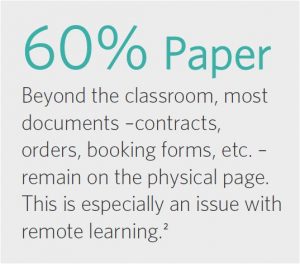Increase Efficiency and Save Operational Expenses in Educational Institutions
Curated by eBizDocs – based on a Kodak alaris Solution Brief
Education, from kindergarten through higher ed., faces a unique array of challenges.
But none so pressing as: how do you optimize processes on such tight budgets?
Getting Education Un-Stuck
 It’s no surprise that, because of regulatory demands and stringent resources, educators lag other industries when it comes to digital systems. Only 23% of higher education office environments are “clear-desk, mostly paper-free” – paper is everywhere in schools.1
It’s no surprise that, because of regulatory demands and stringent resources, educators lag other industries when it comes to digital systems. Only 23% of higher education office environments are “clear-desk, mostly paper-free” – paper is everywhere in schools.1
– 40% say that the problem is lack of efficient software automation.1
But hardware is at least as much the problem:
– 41% cite lack of hardware solutions as a barrier to process automation.1
Any way you look at it, the technological needs of educators are largely unmet
Solve Today, Transform Tomorrow
There is a social good aspect to education: improving workflows in schools yields long-term benefits for students. In the near-term, educators are frustrated by the time they spend in paper processes.
So where exactly is the frustration coming from? Most schools have between 18 and 30 scanners, and each faculty member generally conducts between 12 and 20 scans per week.2 But between all possible “workflows” – grading homework and tests, new student admission, kindergarten screening, curriculum development and recording grades – there are clear winners in terms of difficulty due to paper-based systems.
 For example, 70% of faculty in elementary schools use paper to record grades. In high schools, this number drops to only 25%.2
For example, 70% of faculty in elementary schools use paper to record grades. In high schools, this number drops to only 25%.2
But across the board from K-12, 81% of teachers must manually enter paper-based grades into the grading software. In high schools, the number is highest: 85%.2 Since 75% of tests are administered on paper even today, this is a struggle. Despite the proliferation of electronic grading records, data entry is still highly manual.
In order to win the hearts of teachers and educational administrative staff, the solution must appeal to the obvious: faculty spend too much time with the “manual stack” – paper-based processes that hinder productivity and student development. Automating information capture will provide huge payoffs to educators, in records management as well as curriculum development and new student admissions (particularly kindergarten screenings).
And beyond reducing time and cost, advancing information capture will transform educational efficacy.
“Most importantly, digitization is allowing us to better advocate for our veteran students. All departments can now work together more efficiently so our students can achieve their education goals smoothly and in less time.”
Jennifer Koopman VRC Coordinator, Great Basin College
Solutions Using Scanners and Advanced Capture Software Enable Digital Student Record Sharing Ease
Great Basin College (GBC), founded in 1967, is a public college in Elko, Nevada. With 3836 students enrolled online from across the country and at campuses across 86,500 square miles, two time zones, and ten of Nevada’s largest counties, GBC needed to move their student records to a digital format.
Prior to using Kodak Alaris scanners, the staff had to print and/or copy documents and then hand carry them between departments across campus. With the manual system in place, paper was a bottleneck, information security was at risk and human error/loss of personal data became a serious concern.
GBC found that by using scanners and software, the resulting digitization improved collaboration between departments while providing a secure environment for exchanging sensitive information.
“The Kodak Alaris scanner is quick with no jams and produces great images. We have had no need for rescans which really speeds up our process.”
John Green Veterans Resource Centers Assistant Coordinator, Great Basin College

But benefits aren’t limited to higher education: between 60% and 80% of new student/new kindergartener registration documents are submitted on paper, from screening forms to medical records to emergency contact forms.
A blend of distributed and production scanners along with advanced capture software is often a fit for education, due to the variety of paper – both small and large batches – and scanning irregularity.
1. Higher education stats: AIIM Three Reasons Higher Education Pros are Recruiting ECM, 2017
2. K-12 Stats: InfoTrends: Business Process Automation in K-12 Education, 2017
Take the next step by starting a fact finding, no obligation, conversation with eBizDocs about your goals and objectives.
About eBizDocs –eBizDocs is a premier digital transformation provider focused on helping you put INFORMATION AT YOUR FINGERTIPS. Offerings include paper and microfilm conversion, content capture and document management solutions, scanner sales and service, and process consultation. eBizDocs is SOC2 Type II certified and serves private and public-sector organizations. The company has been in business for over 20 years and is a preferred source contractor for NYS entities. To learn how eBizDocs can help transform your operation, visit eBizDocs.com.


